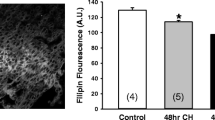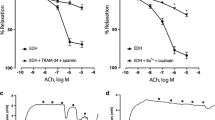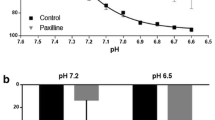Abstract
Several authors have alluded to the possible involvement of EDRF (NO) in ischemia-induced coronary artery dilation. Alternatively, it has been suggested that opening of ATP-dependent K channels could play a key role in this context. We studied the effects of sulfonylureas and NG-nitro-L-arginine (LNNA), a specific inhibitor of endothelial NO (EDRF) synthesis, on ischemia-induced coronary vasodilation in isolated Langendorff-perfused guinea pig hearts arrested with 15 mM KCl in normal Tyrode, and isolated pig coronary arteries precontracted with 43 mM KCl. In Isolated Langerdorff-perfused guinea pig heart, when hypoxia was simulated by switching 100% O2 in the perfusate to 100% N2, coronary perfusion pressure (CPP) fell from 90 cm H2O by 45 ± 5 cm H2O. In the presence of LNNA, a specific inhibitor of NO synthetase in endothelial cells, CPP dropped by 44 ± 6 cm H2O (n = 6; ± SEM, no statistically significant). On biochemical simulation of ischemia (addition of iodoacetate [IAA]), CPP dropped 40 ± 6 cm H2O, and in experiments performed under the same conditions but in the presence of LNNA, CPP dropped by 38 ± 5 cm H2O (n = 6; ± SEM; not statistically significant). When ischemia was simulated metabolically by equimolar replacement of 10 mM glucose with 2-deoxyglucose (DOG), an inhibitor of glycolysis CPP decreased by 24 ± 1 cm H2O (n = 6; ± SEM) after 15 minutes. This fall in CPP was almost prevented by 20 μM glibenclamide, whereas in the presence of 20 μM LNNA the DOG-induced decrease in CPP was not significantly inhibited, and CPP decreased by 22 ± 2.6 cm H2O (n = 6; ± SEM). In isolated pig coronary artery rings, maximal tension, achieved by depolarizing the smooth muscle cells by 43 mM KCl, decreased by 37 ± 7% upon simulated hypoxia by replacing 100% O2 with 100% N2 in the perfusate (n = 6; ± SEM) in arteries with intact endothelium. In arteries without endothelium, maximal tension also dropped by 35 ± 6% (not statistically significant). In the same experiments the decrease in tension could be largerly inhibited in the presence of 50 μM glibenclamide. Our results clearly show that in isolated perfused guinea pig hearts, as well as in isolated pig coronary arteries, EDRF does not play a decisive role in the coronary dilatory response to hypoxia and ischemia.
Similar content being viewed by others
References
Gasser R, Brussee H, Wallner M, et al. Current views on mechanisms of vasodilation in response to ischemia and hypoxia. Int J Angiol 1993;00:22-32.
Furchgott RF. Role of endothelium in responses of vascular smooth muscle. Circ Res 1983;53:557-573.
De Mey JG, Vanhoutte PM. Anoxia and endothelium-dependent reactivity of the canine femoral artery. J Physiol 1983;335:65-74.
Busse R, Föstermann U, Matsuda H. The role of prostaglandins in the endothelium-mediated vasodilatory response to hypoxia. Pflüg Arch 1984;401:77-83.
Chen G, Suzuki H. Some electrical properties of the endothelium-dependent hyperpolarization recorded from rat smooth muscle cells. J Physiol 1989;410:91-106.
Cryer A. Biochemical Interaction at the Endothelium. Amsterdam: Elsevier Press, 1983.
Feletou M, Vanhoutte PM. Endothelium-dependent hyperpolarization of canine coronary smooth muscle. Br J Pharmacol 1988;93:515-524.
Furchgott RF, Zawadzki JV. The obligatory role of endothelial cells in the relaxation of arterial smooth muscle by acetylcholine. Nature 1988;288:373-376.
Headrick JP, Berne RM. Endothelium-dependent and-independent relaxations to adenosine in guinea-pig aorta. Am J Physiol 1990;259:H62-H67.
Kelm M, Schrader J. Control of coronary vascular tone by nitric oxide. Circ Res 1990;1561-1576.
Kwan YW, Wadsworth RM, Kane KA. Hypoxia and endothelium-mediated responsiveness of circumflex coronary artery rings from sheep. Br J Pharmacol 1989;96:857-863.
Vanhoutte PM, Houston DS. Platelets, endothelium and vasospasms. Circulation 1986;72:728-734.
Rubanyi GM, Vanhoutte PM. Hypoxia releases a vasoconstrictor substance from the canine vascular endothelium. J Physiol 1985;364:45-56.
Sobey CG, Woodman OL. Myocardial ischemia: What happens to the coronary arteries? TIPS 1993;14:448-453.
Nelson MT, Patlak JB, Worley JF. Calcium channels, potassium channels and voltage dependence of arterial smooth muscle tone. Am J Physiol 1990;259:C3-C18.
Standen NB, Quayle JM, Davies NW, Brayden J, Huang Y, Nelson MT. Hyperpolarizing vasodilators activate ATP-sensitive K-channels in arterial smooth muscle. Science 1989;245:177-180.
Gasser R, Klein W, Kickenweiz E. Vasodilative response to ischemia is mediated by ATP dependent K channels in the guinea pig thoracic aorta. Angiology 1992;44:228-243.
Brussee H, Gasser R, Grisold M, et al. EDRF does not mediate coronary vasodilation secondary to simulated ischemia: A study on KATP channels and Nw-nitro-1-arginin on coronary perfusion pressure in isolated Langendorff-perfused guinea pig hearts. Eur Heart J 1994;15(Suppl.):148.
Attwell D, Eisner D, Cohen I. Voltage clamp and tracer flux data: Effects of a restricted extracellular space. Rev Biophys 1979;12:213-261.
Daut J, Maier-Rudolph W, von Beckerath N, Mehrke G, Günther K, Goedel-Meinen L. Hypoxic dilatation of coronary arteries is mediated by ATP-sensitive potassium channels. Science 1990;247:1341-1344.
Dart C, Standen NB. Adenosine-activated potassium current in smooth muscle cells isolated from the pig coronary artery. J Physiol 1994;471:767-786.
Berne RM. Cardiac nucleotides in hypoxia: Possible role in the regulation of blood flow. Am J Physiol 1963;204:317-322.
Dart C, Standen NB. Activation of ATP-dependent K channels by hypoxia in smooth muscle cells isolated from the pig coronary artery. J Physiol 1995;483:29-39.
Vanheel B, Leybert L, de Hemptinne A. Simulated ischemia and intracellular pH in isolated ventricular muscle. Am J Physiol 1989;257:C365-C376.
Gaskell WH. On the tonicity of the heart and blood vessels. J Physiol 1880;3:48-75.
Davies NW. Modulation of ATP-sensitive K channels in skeletal muscle by intracellular protons. Nature 1990;343: 375-377.
Gasser R, Vaughan-Jones RD. Mechanism of potassium efflux and action potential shortening during ischemia in isolated mammalian cardiac muscle. J Physiol 1990;431: 713-741.
Kleber A. Extracellular potassium accumulation in acute myocardial ischemia. J Mol Cell Cardiol 1984;16:389-394.
Weiss J, Shine I. Extracellular K-accumulation during early myocardial ischemia, implications for arrhythmogenesis. J Mol Cell Cardiol 1981;13:699-704.
Weiss J, Shine I. Extracellular K-accumulation during myocardial ischemia in isolated rabbit heart. Am J Physiol 1982;242:H619-H628.
Kantor PF, Coetsee WA, Carmeliet EE, Dennis SC, Opie LH. Reduction of ischemic K loss and arrhythmias in rat hearts. Effect of glibenclamide, a sulphonylurea. Circ Res 1990;66:478-485.
Mc Carron JG, Halpern W. Potassium dilates rat cerebral arteries by two independent mechanisms. Am J Physiol 1990;259:H902-H908.
Bünger R, Haddy FJ, Querengässer A. Studies on potassium induced coronary dilatation in the isolated guinea pig heart. Pflügers Arch 1976;363:27-31.
Author information
Authors and Affiliations
Rights and permissions
About this article
Cite this article
Gasser, R., Köppel, H., Brussee, H. et al. EDRF Does Not Mediate Coronary Vasodilation Secondary to Simulated Ischemia: A Study on KATP Channels and Nω-nitro-L-arginine on Coronary Perfusion Pressure in Isolated Langendorff-Perfused Guinea-Pig Hearts. Cardiovasc Drugs Ther 12, 279–284 (1998). https://doi.org/10.1023/A:1007717816652
Issue Date:
DOI: https://doi.org/10.1023/A:1007717816652




